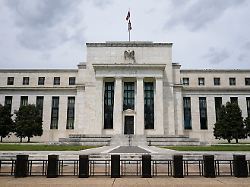Fed postpones turnaround
The US Federal Reserve is not shaking the high key interest rate
May 1, 2024, 8:02 p.m
The US Federal Reserve is sticking with its high interest rate policy. The monetary authorities around Fed Chairman Powell are leaving the key monetary policy rate in the range of 5.25 to 5.50 percent. Because of stubbornly high inflation, the Fed is putting off cutting interest rates.
In view of the stubbornly high inflation in the USA, the Federal Reserve is shying away from a change in interest rates. The monetary authorities left the key interest rate in the range of 5.25 to 5.50 percent. The Fed said there had been no further progress toward its 2 percent inflation target in recent months. A turnaround in interest rates is not appropriate as long as the monetary authorities are no longer confident that the inflation rate will sustainably approach the Fed’s target of two percent.
Central Bank boss Jerome Powell had already made it clear that the high interest rate policy would have to continue for longer in order to break the wave of inflation. At the same time, he had signaled that the Fed would slow down the pace of its balance sheet reduction “fairly soon”: It has now announced that from June onwards it will only allow US government bonds worth up to $25 billion to expire each month without replacing them . Previously the upper limit was $60 billion per month. When it comes to mortgage-backed securities (MBS), the Fed maintains the practice of allowing up to $35 billion worth of securities to mature each month without replacing them. With these measures, the central bank is reducing its balance sheet, which was bloated during the corona pandemic. Slowing the pace of balance sheet deleveraging, Powell believes, will reduce the likelihood that the Fed will over-execute and thereby disrupt money markets.
Interest rate turnaround only in November?
The Fed sees balance sheet reduction and interest rate policy as separate measures. However, both have contributed to the central bank taking a tight line. Nevertheless, the central bank has not yet gotten the strong price rise under control. The inflation rate was recently at 3.5 percent, well above the central bank’s target of two percent. Given the Fed’s lack of success on the inflation front, traders in the futures markets expect the central bank to possibly delay a rate cut until November. Just a few weeks ago there was speculation about June as the likely time for the interest rate turnaround.
The good economic situation, especially the strong labor market, gives the central bank the leeway to wait before easing monetary policy, says KfW chief economist Fritzi Köhler-Geib: “The probability of an interest rate cut before the summer break has therefore been significantly reduced.” The Fed still lacks confidence that inflation will develop more in line with price stability, says economist Bastian Hepperle from Hauck Aufhäuser Lamp Private Bank. She will therefore continue to keep her interest rate policy tight: “There is no easing in sight before September, and only if the Fed doesn’t take the two percent price target too seriously.”
